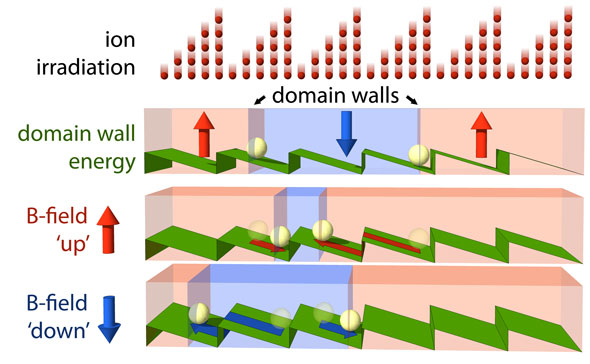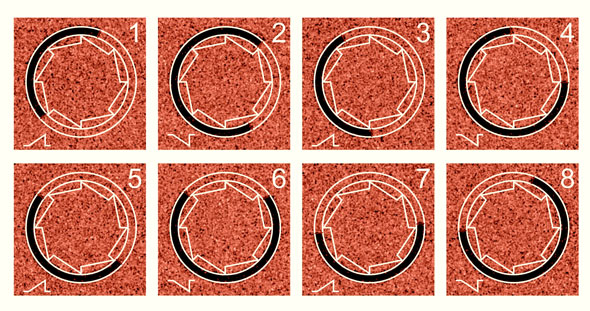| Jul 23, 2012 |
'Rattle memory', new computer memory thanks to nanotechnology
|
|
(Nanowerk News) Researchers from the FOM Foundation and Eindhoven University of Technology have successfully made a 'magnetic domain-wall ratchet' memory, a computer memory that is built up from moving bits of magnetised areas. This memory potentially offers many advantages compared to standard hard disks, such as a higher speed, lower electricity consumption and much longer life. Using concentrated ion bundles the researchers have influenced the magnetic wires the bits move through, and they have successfully controlled bits at the nanometre scale and subsequently constructed a new memory. The research results will appear on the cover of the August issue of the authoritative journal Nature Nanotechnology ("Shift registers based on magnetic domain wall ratchets with perpendicular anisotropy"; free access).
|
 |
| Ion irradiation creates an asymmetric potential or 'ratchet' for the main walls (visualised as light-yellow spheres). The bit with a magnetic coating is shifted one position to the left by sequentially positioning a field upwards and downwards.
|
|
The bits in a nanowire can be conceptualised as areas that can have two possible magnetic directions, a 0 or a 1. Usually all of the bits are simultaneously set at either 0 or 1 during the construction as they reverse like compass needles. The researchers have now demonstrated that bits can be coherently transferred without the information they contain being lost. This method of magnetic data transport is radically different from that in current computers, where rotating magnetic disks are mechanically moved to address data.
|
|
Saw tooth
|
|
By cleverly varying how the ions are fired across a nanowire, a repeating, saw-tooth-shaped energy landscape is created. This asymmetric saw tooth is crucial: it forces a domain wall, the boundary between bits, to move in a single direction under a variable magnetic field. Due to the variable magnetic field the force on the domain wall continually reverses and this is alternately pushed over the incline and then subsequently pushed back against the sharp edge (see Figure 1). After one cycle of the magnetic field two domain walls are pushed up by exactly one position. This net transfer of a bit would be impossible without saw-tooth potential! Figure 2 also shows the first experiment with a circular magnetic wire: two domain walls move under the influence of a variable magnetic field in an anticlockwise direction. By using this circle the domain walls can always rotate and the bits are retained. This one-way traffic of the domains is a movement comparable to that of a rattle or 'ratchet'.
|
 |
| In a 0.5 nm-thick cobalt ring with a diameter of 12 µm, a bit (black) is coherently transferred in a variable magnetic field (~16 mT) in an anti-clockwise direction.
|
|
Unique opportunities
|
|
The discovery made at Eindhoven University of Technology offers unique opportunities for the development of alternative memory concepts. After the proof-of-principle experiments the scientists will focus on a next generation ratchet. This will be based on radical new effects such as the use of spin currents generated in the neighbouring non-magnetic layers or the use of electric fields to influence the domain or movement. These are fascinating challenges at the interface of fundamental science and nanotechnology.
|


